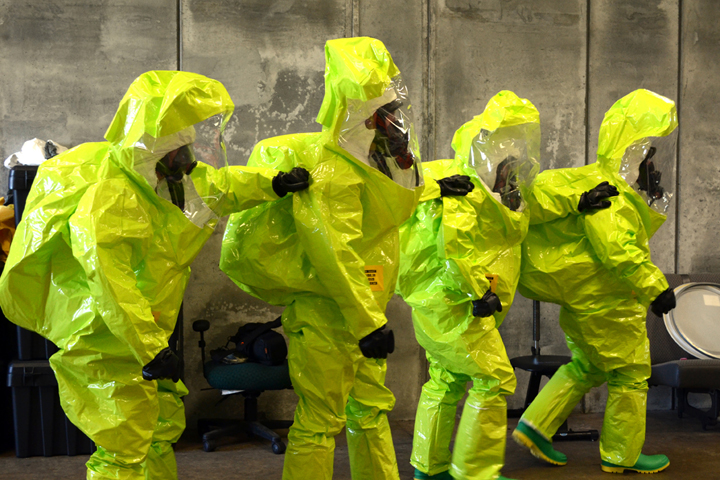Sunshine Education and Research Center links multiple disciplines to improve the wellbeing of workers
First published on July 13, 2015 in observance of the COPH’s 30th anniversary celebration.
Founded in 1997 by a training grant supported by the National Institute for Occupational Safety and Health, the Sunshine Education and Research Center at the USF College of Public Health stemmed from an industrial hygiene training program grant in the late 1980s.
“NIOSH has several charters,” explained Dr. Thomas Bernard, chair and professor in Environmental and Occupational Health and SERC (pronounced SIR-see) program director since 2008. “One of them is to support and encourage the development of professionals in the field of occupational safety and health. A mechanism for doing that is through training grants.”
After Bernard’s arrival in 1989, additional training program grants followed in occupational medicine and occupational health nursing. Then the department began work on an occupational safety program. Eight years later, the fledgling operation had grown enough to warrant centralization.
“In the mid-’90s,” Bernard said, “we decided that we would combine those training activities with a grant and ask for an education center. The application required that it have training in at least three programs, and we had four: safety, industrial hygiene, medicine and nursing. The application was accepted and funded under the leadership of Stuart M. Brooks and Yehia Hammad.”
Being headquartered at a university the size of USF naturally leads any interdisciplinary entity into an expansion cornucopia that Bernard is happy to enumerate, along with the USF colleges involved.
“Because they are multidiscipline programs, part of their value is the interdisciplinary training,” he said. “We added, about seven years ago, occupational health psychology, so that’s now a funded program in Arts and Sciences. We’ve expanded the safety program to include a degree out of engineering. Obviously, we’re involved with the [Morsani] College of Medicine: The clinical rotations and residency certificates come out of medicine, and then the academic training comes out of public health.
“With nursing,” he said, “we have three options. One is a straight occupational health nursing degree, a second one is a dual degree in nursing and public health, and then we also have a third degree that’s strictly public health.”
Another requirement under the grant from NIOSH, which is part of the Centers for Disease Control and Prevention, is a continuing education component, which also has been added. Additional expansion has stemmed from outreach activities, student recruitment and a pilot project in research training for doctoral students and junior faculty.
“We support these throughout the region,” Bernard qualified, “so they aren’t only for USF. We have reached way beyond ourselves in terms of the arrangements that we have, but we engage the professional community more than the community at large.”
He added that the center is “very much engaged” in state and regional professional conferences, as well as in coordination with other ERCs in the state and the region.
“By and large, we have a very good national profile,” he said. “There are just a couple of us that reach out globally, but those are more individual efforts. The ERC is designed to serve primarily Florida, and in a larger sense, the Southeast region. That’s our mission and our charter from NIOSH, not to go beyond that, but I think we have expertise in a number of areas that have national recognition.”
The highly technical nature of some of those areas probably help limit recognition to professional circles, but their significance would be difficult to deny. Respiratory protection from nanoparticles is one of them, but as Bernard pointed out, it’s not exactly a topic on most people’s minds.
“Few people are asking, ‘What happens when you breathe those in?’ Some of them have characteristics that are not unlike asbestos. Others are easily transported across the air-blood barriers, so they move through the lungs into the blood and get transported elsewhere in the body. So protecting individuals from nanoparticles is important,” he said.
And the list goes on.
“We have a major presence in the area of heat stress – how to evaluate heat stress, how to manage it, and especially, the effects of protective clothing. We have fairly good recognition in Europe in the area of ergonomics,” he continued, “and occupational health psychology clearly is one of our well-recognized programs.”
Workplace stress, safety climate and work-family balance are others, he said.
“And then,” he concluded with a nod that said he’d saved the best for last, “we turn out good students, and we’re recognized through the product of the quality of our students.”

SERC hosts a six-day Summer Institute for Occupational Health and Safety for students interested in exploring graduate studies.
Looking ahead is easy for Bernard, and he likes what he sees for his organization.
“I think that everything we do in public health, and everything we do within the SERC, is prevention – preventing people from being injured or having their health impaired,” he said. “But I think our opportunity here at USF lies in translating research to practice and also expanding on the fact that a healthy workforce is healthy not only from controlling exposures to hazards in the workplace, but also from encouraging healthy activities outside the workplace.
“So, bringing these work and home lives together is an opportunity for us,” Bernard concluded, “and that’s where I see our future.”
Story by David Brothers, College of Public Health.



